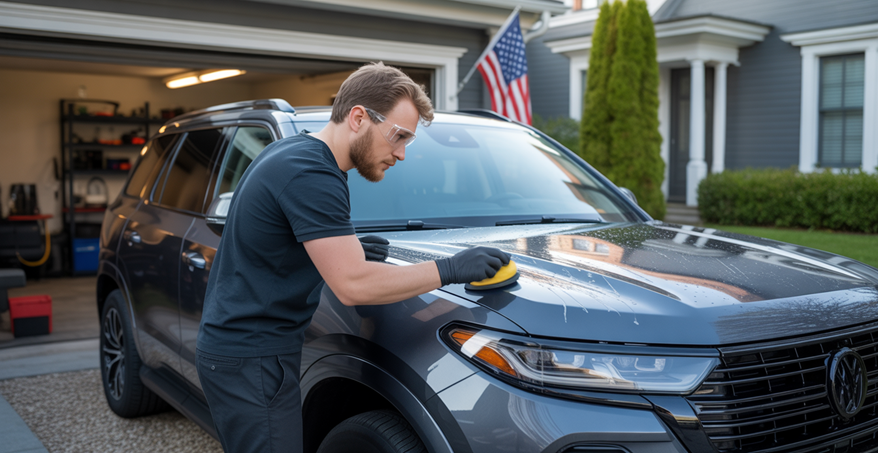Discover the truth about DIY ceramic coating and how it stacks up against pro-grade detailing services.
In 2025, the automotive detailing industry is experiencing a shift. More car enthusiasts are turning to DIY ceramic coating kits promising professional-grade protection at a fraction of the price. With luxury vehicles like the BMW X5 ($66,000–$89,000) and Tesla Model Y ($45,000–$58,000) becoming more mainstream, protecting the paint from UV rays, acid rain, and debris has become essential for preserving resale value and aesthetics.
But does a $70 DIY ceramic kit offer the same protection as a professional $1,500 ceramic coating application done by a certified detailer? The answer is nuanced—and understanding it requires diving deep into application methods, chemical composition, durability, and expected results.
What exactly is ceramic coating?
Ceramic coating is a liquid polymer applied to a vehicle’s exterior that chemically bonds with the factory paint. The goal? To create a hydrophobic, UV-resistant layer that enhances gloss, simplifies cleaning, and repels contaminants.
Professional ceramic coatings typically use advanced formulas like SiO2 (silicon dioxide) concentrations above 80%, often reinforced with graphene oxide in 2025 models. These coatings are applied in temperature-controlled environments and require meticulous paint correction beforehand, sometimes taking up to 8 hours of labor.
In contrast, most DIY kits available at retailers like AutoZone or Amazon feature lower SiO2 content, usually around 30–50%, and don’t require professional tools. They’re designed for ease of use, promising protection that can last between 6 to 12 months.
Performance comparison: DIY vs. professional ceramic coating
| Feature | DIY Ceramic Coating ($50–$150) | Professional Ceramic Coating ($1,200–$1,800) |
|---|---|---|
| Application time | 1–2 hours | 6–10 hours |
| Expected durability | 6 to 12 months | 3 to 7 years |
| Gloss and shine | Moderate | Deep, high-gloss showroom finish |
| Hydrophobic properties | Good | Excellent |
| Paint correction included | No | Yes (often includes multi-stage correction) |
| Warranty | None | 2–7 years (depending on brand/tier) |
For vehicle owners of premium models like the Audi Q8 e-tron ($75,000–$95,000) or Lexus RX 500h ($63,000–$72,000), professional ceramic coating may be a wise investment, especially if long-term paint protection and resale value are priorities. However, for daily drivers or leased vehicles, DIY kits provide a solid level of protection without the heavy financial commitment.
Key factors to consider before choosing a coating method
1. Paint condition
Ceramic coatings amplify the current state of your paint. If your car has swirl marks, oxidation, or water spots, a professional paint correction (often included in $1,500+ treatments) is essential before sealing in imperfections.
2. Time and effort
DIY coating requires patience, careful surface prep, and consistent application. Rushed jobs often result in streaking or premature wear. For those without a garage or detailing experience, hiring a professional minimizes risks.
3. Environment
In regions like California or Florida, where UV exposure and humidity are significant, a higher-grade ceramic coating ensures better resilience. DIY coatings may degrade faster under intense environmental conditions.
What top-tier detailers offer for the $1,500+ price tag
At this price point, vehicle owners receive a comprehensive service package that may include:
-
Decontamination wash and clay bar treatment
-
Multi-stage paint correction
-
High-SiO2 or graphene-infused ceramic coating
-
Curing with infrared lamps
-
Application of ceramic on wheels, glass, and plastic trims
-
Written warranty for multi-year protection
This type of service is often reserved for exotic and luxury vehicles like the Porsche Taycan Turbo S ($190,000) or Mercedes-Benz EQS ($105,000–$125,000), but the benefits extend to any car where long-term protection and perfection are priorities.
How to get the best results with a DIY kit
For those opting for the DIY route, success lies in preparation and patience. Follow these tips for optimal performance:
-
Wash and dry your car thoroughly
-
Use a clay bar or iron remover to decontaminate the surface
-
Apply the coating in a shaded, dust-free environment
-
Buff off the product within the instructed time frame
-
Avoid exposure to water for at least 24 hours post-application
Some of the most popular DIY kits in 2025 include brands like Turtle Wax Hybrid Solutions, Cerakote, and Adam’s UV Ceramic, ranging from $60 to $130, depending on size and kit inclusions.
Choosing what’s best for your vehicle and budget
Every driver has a different goal—some want protection on a budget, while others demand showroom-quality gloss and multi-year durability. In today’s market, DIY ceramic coatings can deliver remarkable results, especially for newer vehicles like the Toyota RAV4 Hybrid ($33,000–$39,000) or Ford Maverick ($25,000–$31,000).
However, professional ceramic coating treatments remain the gold standard for owners seeking maximum longevity, hydrophobic performance, and unmatched aesthetic enhancement.
Ultimately, the choice depends on your vehicle’s value, usage pattern, and commitment to upkeep. Both paths offer viable protection—it’s about selecting the right one for your car’s journey.


